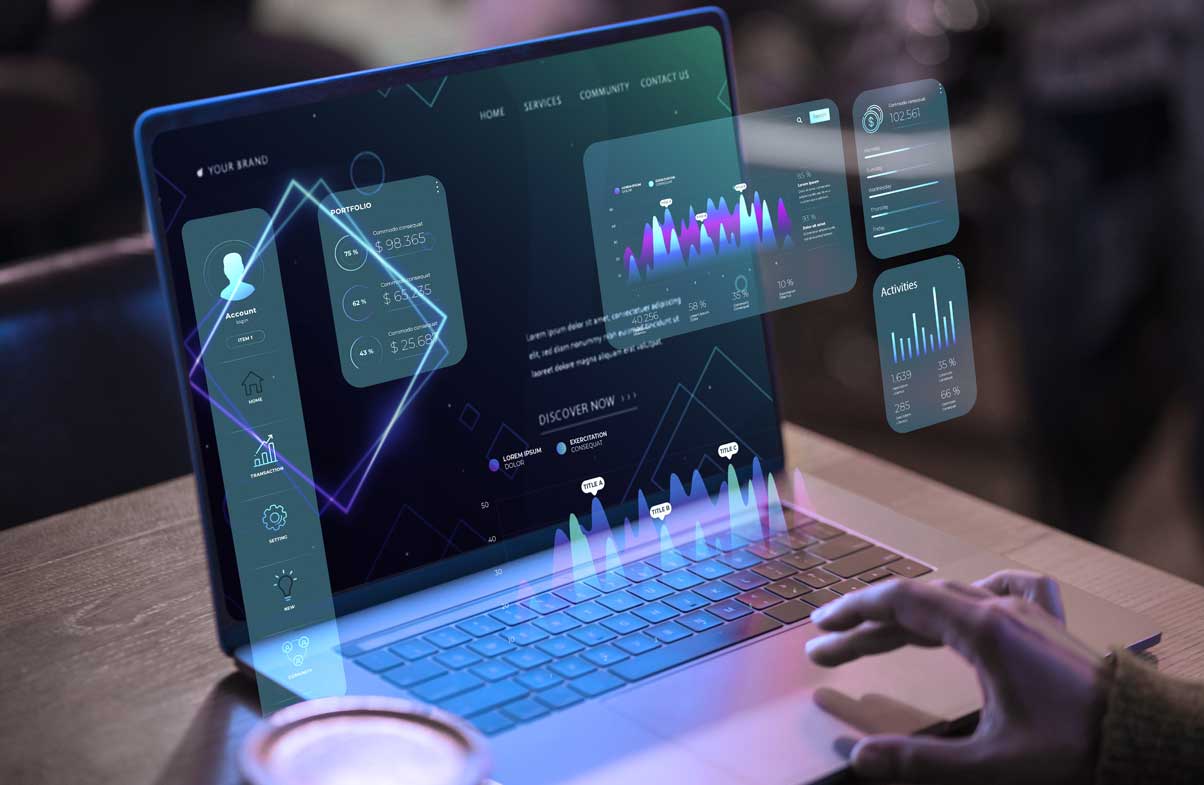SaaS Application Development: A Comprehensive Guide for Businesses

18 Feb 2025
It's a fact that SaaS applications have been becoming more crucial in present business operations, as they are more accessible, highly scalable, and inexpensive compared to traditional software.
The following blog assists with the understanding of the development of SaaS applications, underlining the best practices, services, platforms, frameworks, and consulting solutions. Whether you're a developer looking to build SaaS applications or a business seeking top SaaS application development companies, this guide covers full-cycle SaaS application development services, costs, and deployment strategies.
1. What is a SaaS application?
SaaS applications are cloud-based software solutions that the user can access through the internet, with no need to install or maintain servers locally. These applications usually come on subscription, whereby a business pays regularly for using them. They also allow resource scaling based on demand, which lets businesses adapt to changing needs without significant financial investments.
Key Characteristics of SaaS
Multi-tenancy:
The SaaS system has multi-tenancy, allowing many users to share the same infrastructure and code bases, thus lowering costs and maximizing resources.Scalability:
SaaS systems are designed to scale resources upwards with increased consumption demands without performance degradation.Accessibility:
SaaS applications are accessible on any device connected to the internet. This fosters remote collaboration and higher productivity among users because they can work from anywhere.
2. Common Use Cases and Industries Using SaaS
Customer Relationship Management:
Web-based CRM systems are quite common to maintain sales records among business enterprises for improving customer relationships by providing facilities for contact management and sales tracking, for example, Salesforce.Human Resource Management:
Workday and BambooHR are some SaaS movers in the field of HR, enhancing efficiency within the HR departments for maintaining records about different areas of human resources, including recruitment, payroll management, performance management, and employee self-service.Project Management:
SaaS project management tools include Jira, Asana, and Trello, which facilitate collaboration among team members by monitoring projects and having work allocated along with communication.E-commerce Platforms:
Shopify and BigCommerce are some of the SaaS e-commerce that have eased the way companies manage, scale, and sell products with such ease online. The features include management of products, payment processing, and order fulfillment.Financial services:
On a QuickBook, Xero, or other SAAS applications that were in place accounting, invoicing, reporting, and tracking are required to maintain books of the expenditure and payroll. SaaS apps range from customer relationship management with scalable, accessible, and cost-effective solutions and HR process streamlining to making project management work.
3. Key Benefits of SaaS for Businesses
Cost-effectiveness and reduced IT overhead:
It has less upfront cost and a lesser requirement for extensive IT resources.Accessibility and remote collaboration:
Access applications from anywhere, thus helping teams to collaborate more.Scalability and flexibility:
Resources can be scaled up or down depending on demand in the business.Automatic updates and maintenance:
Get features and security patches automatically.Advantages of Security and Compliance:
Better security with adherence to the standards of your industry.
4. Steps to Develop a SaaS Application
To ensure your application is developed and deployed on time, it’s beneficial to hire SaaS application development services from an experienced team such as NanoByte Technologies. We provide the best SaaS application development solutions that cater to specific business needs, whether you’re building a SaaS software development life cycle or implementing a SaaS e-commerce platform like Shopify.
When selecting a SaaS application development platform, cloud solutions like Azure SaaS application development or AWS SaaS can help scale your application effectively and securely. These platforms offer robust infrastructure and tools for easy deployment.
The SaaS application development process is systematic and includes all the necessary elements to produce a successful and scalable solution.
4.1. Market Research & Idea Validation
The first step towards SaaS application development is performing ample market research and validating your idea.
Determining Business Needs and Market Gaps:
Make use of market trends, industry information, and prospective user insights.Analyzing competitors' strengths and shortcomings:
To determine their unique selling propositions is known as competitor analysis.Clearly defined user personas and target audiences:
Modifying the application to suit particular requirements and tastes.
4.2. Planning & Defining Features
Planning and defining the features of your SaaS application is crucial to make it meet the expectations of users and provide value.
Core features:
Ascertain which MVP features are essential and make plans for upcoming additionsEssential SaaS Features:
Multi-tenancy, API connectivity, and billing/subscription management are examples of essential SaaS capabilities.UI/UX considerations:
To improve user experience and happiness, make sure the interface is clear and easy to use.
4.3. Choosing the Right Technology Stack
The selection of proper technologies for your SaaS application is important in terms of performance, scalability, and security.
Frontend and backend technologies:
Select technologies that are scalable, reliable, and simple to create.Database and cloud infrastructure:
For efficient operation and data storage, use scalable, reliable infrastructure.Security and compliance:
To secure user data, put in place the required security measures and follow industry standards.
4.4. Development & Prototyping
Development and prototyping involve the building and testing of the first version of your SaaS application.
Agile SaaS Development Methodology:
Using agile development methodologies for flexibility, iterative improvement, and frequent releases.MVP Building:
Build a basic version of your application with core features to test it with early users and get feedback.Iterative Development and Feedback Loop:
Improve your application through continuous user feedback and iteration development cycles.
4.5. Testing & Quality Assurance
Thorough testing and quality assurance are essential to ensure your SaaS application performs as expected and is secure.
Functional and performance testing:
Verifies that the program satisfies specifications and manages load efficiently.Security and compliance testing:
Preserves user information and guarantees that rules are followed.User Acceptance Testing (UAT):
Verifies the application's goal and the concerns of the intended audience.
4.6. Deployment & Hosting
Performance optimization and selecting the appropriate cloud infrastructure are part of deploying your SaaS application.
Cloud Deployment Options:
Select scalable and dependable cloud deployment solutions, such as Google Cloud, AWS, and Azure.CI/CD pipelines for automated deployment:
To ensure a smooth procedure, implement CI/CD pipelines for automatic deployment.Load balancing and performance optimization:
To achieve high availability and optimal performance, use load balancing strategies.
4.7. Post-Launch Maintenance & Support
For your SaaS product to continue to succeed after launch, maintenance and support are crucial.
Application Performance Monitoring:
The performance of the program needs to be checked at regular intervals, and any errors found must be corrected on the spot.Feature Updates and Security Patches:
The brilliance of the program comes with regular feature upgrades and security patches.Continuous Customer Support and Issue Resolution:
The company shall always support the customers unconditionally for continuous improvement in issue resolution to achieve customer delight. Above-listed techniques will help you build a solid, scalable, and user-friendly SaaS application. This will be market-ready for the growth of your business.
5. Challenges in SaaS Development & How to Overcome Them
Software as a Service development is exciting and challenging both at once. Following are various perspectives on these problems and methods for their solution:
5.1. Data Security and Privacy Concerns
Challenge:
The challenge might be keeping users' data securely and privately, and this may be quite difficult due to reputational harm and the need for compliance with stringent laws like CCPA and GDPR.
Solution:
- For both in-transit and at-rest data, use strong encryption.
- Update and abide by data protection laws on a regular basis.
- Put in place robust authorization and authentication procedures.
- Perform security audits and keep an eye out for vulnerabilities in systems.
5.2. Scalability Challenges
Challenge:
Your system must be able to manage higher loads without compromising performance as user demand rises.
Solution:
- Makes use of scalable cloud services to automatically adjust demand.
- To avoid overburden, load balancing is used.
- Makes use of the microservices architecture to scale individual services.
5.3. User Retention and Customer Satisfaction
Challenge:
Keeping users engaged and satisfied is critical for long-term success but challenging.
Solution:
- Gather and respond to user input regularly.
- Provide first-rate customer service through a variety of channels.
- Adapt the user experience to each person's unique behavior.
- Constantly release new features and upgrades.
5.4. Integration with Third-Party Services:
Challenge:
Integrating with external services and APIs can be complex and risky.
Solution:
- For integration and performance tracking, make use of API management tools.
- Assure thorough troubleshooting documentation.
- To identify problems early, carry out thorough integration testing.
- Put in place backup plans for service operation if a third party fails.
Future Trends in SaaS Development:
6.1. AI and Machine Learning Integration:
Trend:
Future SaaS applications will incorporate artificial intelligence and machine learning to offer smarter, more efficient solutions. These innovations will enable businesses to enhance user experiences and automate processes in SaaS app development.Impact:
Expect smarter, more efficient software that can adapt to user needs and improve over time.
6.2. Low-code and No-code SaaS Platforms
Trend:
Low-code and no-code SaaS platforms will democratize the creation of SaaS applications, making it easier for non-technical users to create SaaS applications.Impact:
The pace of innovation would accelerate further, coupled with reduced barriers to entry for developing custom solutions.
6.3. Blockchain for Security and Transparency
Trend:
Blockchain technology is expected to be integrated into SaaS applications, improving security, data integrity, and transparency.Impact:
This can lead to more secure transactions, improved data integrity, and transparent operations.
6.4. Edge Computing and Hybrid Cloud Adoption
Trend:
Edge computing and hybrid cloud models are gaining traction, allowing data processing closer to the source and offering more flexibility.Impact:
This can result in faster response times, reduced latency, and more scalable solutions.
8. Conclusion
In a nutshell, the development of SaaS applications is an interesting journey that promises to scale a business faster and more efficiently than ever. Plan it out in detail, selecting the most suitable SaaS development framework to integrate best practices like API connectivity into one single application. Successful SaaS services require careful planning, technology stack, security, scalability, and user experience. Strong encryption, API management, and ongoing user interaction can overcome issues. Staying ahead in evolving trends is crucial.
NanoByte Technologies is the top SaaS application development company as it helps businesses by bringing in the latest SaaS solutions, scalability, security, and innovation that cater to long-term success. We also offer an aggressive pricing strategy to meet every business need- from small startups to large enterprises, we cover all.





